Introduction: The Unsung Hero of Climbing Footwear
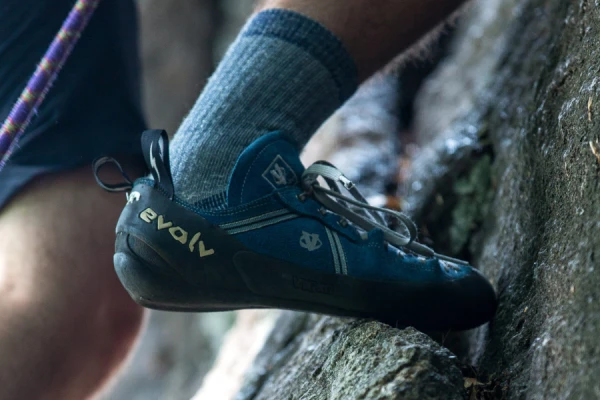
When you think of a climber gearing up, the first image that likely comes to mind is the climber slipping their foot into a tight, sticky rubber shoe—often without a sock. For decades, the mantra was simple: barefoot equals best. The logic behind this was straightforward: the less between the foot and the shoe, the better the climber could “feel” the rock, maximizing sensitivity for precision. However, as climbing shoes evolved, so too did the need for something more than bare skin.
This article explores the dramatic evolution of climbing socks, tracing their history from a simple absence to today’s high-tech solutions, driven by radical advances in climbing shoe design and a growing focus on climber health, comfort, and sustained performance.
The Spartan Start: The Era of Barefoot Sensitivity
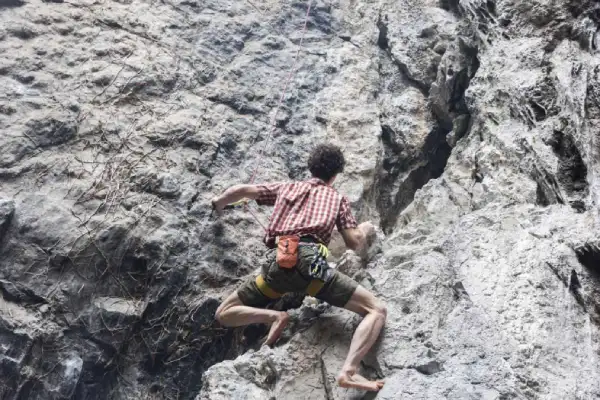
The ‘Barefoot is Best’ Creed
The core argument against socks was rooted in the need for maximum sensitivity. Climbers need to feel the smallest imperfections, edges, and features of the rock or plastic through the rubber sole. The foot itself had to become an extension of the shoe, delivering unfiltered feedback to the brain.
Any intervening layer of fabric was considered a “dead zone” that dampened this crucial tactile input. Furthermore, traditional socks—heavy cotton or thick wool—were unsuitable for the tight, restrictive fit of climbing shoes. They held moisture, caused uncomfortable bunching, and led to inevitable slipping inside the shoe, which is disastrous when trying to maintain an edge.
Early Footwear and the Necessity of Pain
Early climbing footwear, such as simple canvas or leather shoes (like the traditional Kletterschuhe), required a tight, often painful fit to achieve the necessary friction and edging ability. In this context, raw hotspots, blisters, and calluses were often seen less as injuries and more as a badge of honor—the unavoidable cost of high-level climbing.
The Unintended Consequences of Going Barefoot
While going barefoot maximized sensitivity, it presented significant drawbacks, particularly as climbing sessions grew longer and more intense:
- Friction Issues: Direct skin-to-shoe contact led to higher friction, rapidly generating blisters and hot spots, especially on new or aggressively fitted shoes.
- Hygiene and Odor: Damp, warm climbing shoes worn by bare feet create an ideal environment for bacteria. The resulting chronic odor and potential for fungal infections (like athlete’s foot) made the barefoot approach increasingly undesirable for regular or indoor use.
The Footwear Revolution: A New Need for a ‘Second Skin’
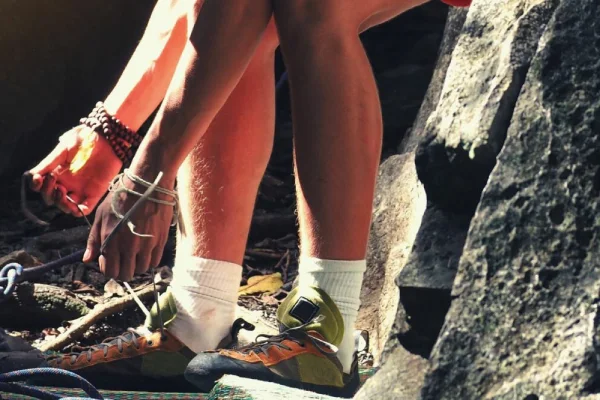
The Birth of Technical Climbing Shoes
The late 1980s and 1990s saw the proliferation of aggressive, downturned, and highly asymmetric shoe designs. These revolutionary shapes were built for maximum power transfer and precision on steep overhangs, fundamentally changing the interior volume and fit.
- Minimized Volume: The new designs minimized internal space, squeezing the foot into a powerful, curled position. This minimized volume made traditional socks utterly impossible, but it also amplified friction and moisture issues without some protective layer.
- Increased Friction: The tighter the fit and the more technical the shape, the greater the opportunity for skin abrasion. Climbers needed a solution that acted as an invisible buffer.
The Rise of Indoor Climbing and Rental Gear
The widespread growth of indoor climbing gyms introduced two new critical drivers for socks:
- Sanitation: For high-traffic rental shoes, wearing a sock became a non-negotiable requirement for sanitation and preventing the transmission of foot infections.
- Comfort for Beginners: New climbers often prioritize immediate comfort over achieving extreme, painful fits, opening a massive market for thin, protective barriers that ease the transition into specialized footwear.
This pressure drove manufacturers to engineer a ‘second skin’—a material that is nearly invisible yet highly functional, protecting the foot without compromising the crucial “feel.”
The Performance Era: Innovations That Transformed the Sock
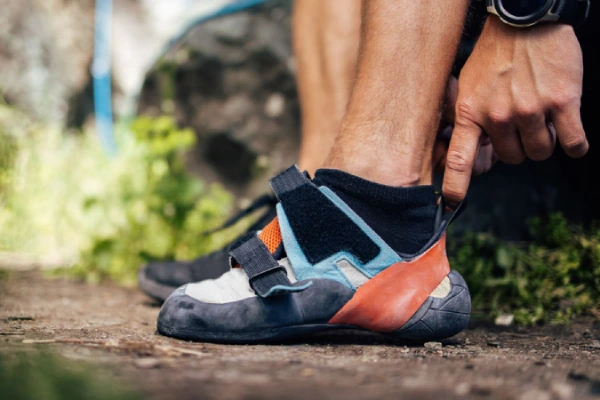
Innovation in Materials: The Moisture-Wicking Mandate
The success of modern climbing socks hinges on advanced fabric technology:
- Synthetic Dominance: Blends of high-quality nylon, polyester, and spandex achieve ultra-thin profiles, exceptional elasticity, and, most importantly, rapid moisture-wicking. These materials actively move sweat away from the skin, preventing the clammy, slippery feeling that leads to blisters.
- The Merino Wool Renaissance: Fine-gauge Merino wool has been adapted for climbing. Unlike bulky traditional wool, this ultra-fine material provides natural temperature regulation (keeping feet warm in the cold and cool in the heat) and inherent anti-odor properties, all while maintaining a minimal profile.
- Blends for Durability: These core materials are almost always blended (e.g., Merino wool with nylon and spandex) to enhance durability, shape retention, and stretch.
Interested in which fabric is right for your next climb? Read our deep dive: How to Choose the Right Material for Your Climbing Socks
Engineering the Perfect Fit: Achieving Barefoot Sensitivity
Today’s climbing socks are designed to offer a “second skin” experience. Ultra-thin construction ensures the sock fits snugly without interfering with the shoe’s fit. The seamless toe design eliminates pressure points and friction in areas where the foot is most constricted, such as the toes. Left and right-specific socks ensure a perfect fit that minimizes bunching and maximizes precision.
Hygiene and Health: The Power of Anti-Odor Technology
Directly addressing one of the biggest drawbacks of barefoot climbing, modern socks integrate permanent hygiene features:
- Antimicrobial Solutions: Fabrics are often infused with specialized antimicrobial treatments (such as silver ions or proprietary Meryl fabrics) that inhibit the growth of odor-causing bacteria.
- This feature is invaluable for climbers who wear their shoes for hours, significantly improving both foot and shoe hygiene and extending the lifespan of the footwear.
How Climbing Socks Impact Performance: Comfort vs. Sensitivity
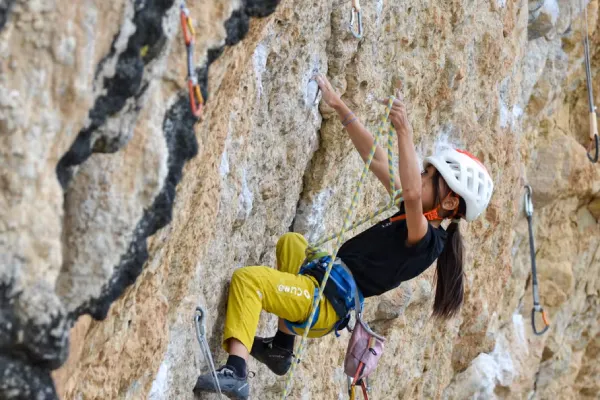
Modern climbing socks have resolved the old debate, turning the decision into one of calculated performance trade-offs rather than a binary choice between comfort and feel.
The balance hinges on your discipline:
- Maximum Sensitivity (Bouldering/Sport Climbing): Climbers tackling extremely difficult, short problems often opt for the absolute thinnest synthetic or fine Merino socks available. These act purely as a protective, moisture-wicking membrane, providing friction reduction while minimizing volume intrusion.
- Maximized Comfort (Multi-Pitch/Trad Climbing): For long days, uncomfortable approaches, or colder environments, climbers might opt for a slightly thicker, cushioned sock, often made with high-performance Merino wool. This provides necessary thermal regulation and fatigue reduction without excessive bulk.
The modern sock allows a climber to tailor their foot environment based on the specific conditions—be it the cold granite of a high-altitude climb or the hot, sweaty plastic of a gym session.
Top Brands and the Modern Standard
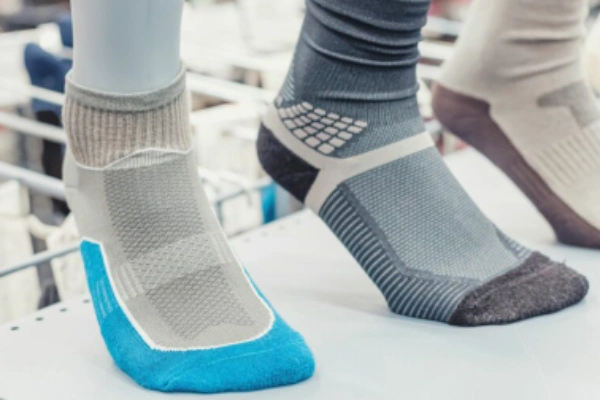
The market now features dedicated manufacturers who specialize in this niche, driving standards higher. Brands like La Sportiva, Roctic, YY Vertical, and Icebreaker offer products that demonstrate how far the technology has come, with some focusing on maximal thinness for performance and others prioritizing Merino-based comfort and multi-pitch durability.
Understanding the subtle differences in their materials and fit profiles is key to optimizing your climbing experience.
Ready to compare the leaders? Check out our brand review: Top Brands for Climbing Socks: A Comparison of Features and Performance
If you’re looking for high-quality, custom-made climbing socks or bulk orders for your business, Max Hosiery offers tailored solutions to meet your specific needs. Contact us today to elevate your climbing gear offerings with our performance-driven, durable, and comfortable socks!
FAQ
Do I really need socks for climbing?
While climbing barefoot can maximize sensitivity, wearing socks improves comfort, reduces friction, and helps with hygiene, especially in rental shoes or long sessions. Socks protect your feet from blisters and calluses.
What material is best for climbing socks?
Merino wool, synthetic fibers like nylon and polyester, and bamboo are popular for climbing socks. Merino wool offers natural temperature regulation and anti-odor properties, while synthetic materials provide moisture-wicking and durability.
Can climbing socks help prevent blisters?
Yes, climbing socks can help reduce friction, a leading cause of blisters. Thin socks made of moisture-wicking material prevent foot slipping inside shoes, minimizing blister risks.
How do I choose climbing socks for cold weather?
For cold weather, opt for thicker socks made from Merino wool or synthetic blends that offer warmth, moisture-wicking, and insulation. Look for socks with added cushioning and durable construction for comfort in long, cold climbs.
Can climbing socks help with foot odor?
Yes, many climbing socks are infused with antimicrobial treatments, like silver-ion technology, to reduce odor. Merino wool naturally resists odor and keeps feet fresh during long climbs or when wearing tight shoes.
